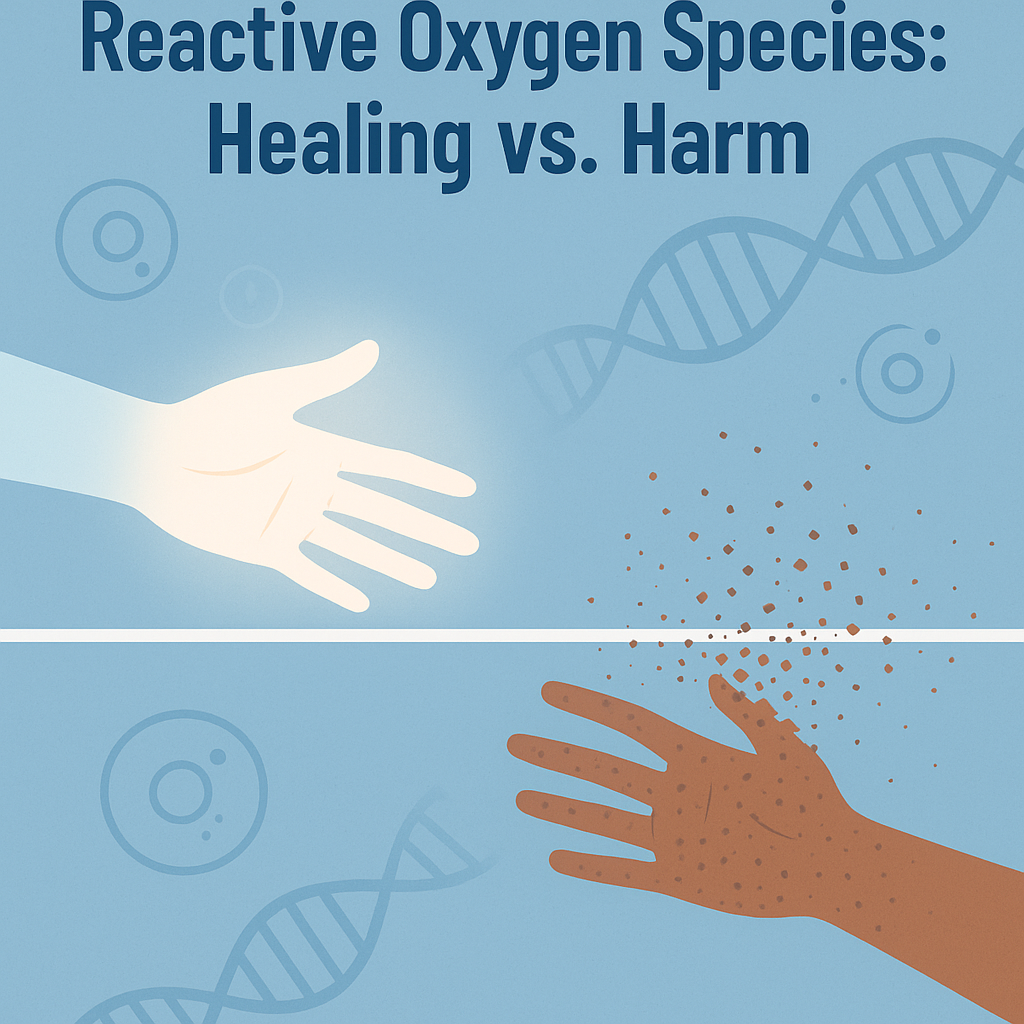ROS in Regeneration—The Paradox
Reactive oxygen species (ROS) play dual roles in tissue regeneration, acting as signaling molecules at low concentrations while becoming cytotoxic at higher levels. Basal bursts of ROS, around 10⁻⁷ to 10⁻⁶ M H₂O₂, activate downstream signaling pathways essential for tissue repair, such as the PI3K/Akt and MAPK cascades, and stabilize key transcription factors like HIF-1α and β-catenin, promoting angiogenesis and osteogenesis [Sheppard et al., 2022]. However, surges above physiological limits can lead to oxidative distress, negatively impacting cellular functions and promoting apoptosis [Chazelas et al., 2021]. Striking a balance within the “Goldilocks zone” of ROS concentration is critical for creating effective regenerative therapies that harness their beneficial effects while curtailing their harmful potential.
Bone Regeneration
Bone regeneration is a highly complex process influenced by ROS dynamics. Following a fracture, hypoxia-induced ROS spikes stabilize HIF-1α and promote the recruitment of osteoprogenitor cells, with lack of proper ROS modulation leading to prolonged healing times [Li et al., 2024]. Chronic hyper-ROS conditions, especially in patients with diabetes, can inhibit the essential coupling of osteoblasts and osteoclasts, ultimately delaying the healing process [Sheppard et al., 2022]. The exploration of materials that can modulate ROS levels—like borate bioactive glass—demonstrates the necessity of integrating redox-sensitive interventions to enhance healing and mineralization in bone tissue [Bădilă et al., 2022].
Skeletal Muscle Repair & Atrophy
Oxidative stress is a significant factor in skeletal muscle repair and the progression of atrophy. Satellite cells are activated by transient increases in ROS, which are critical for the initiation of muscle regeneration [Agrawal et al., 2023]. However, excessive ROS levels can lead to the activation of atrogenes such as MuRF-1 and Atrogin-1, which are responsible for myofibrillar protein degradation and subsequent muscle wasting [Agrawal et al., 2023]. Therapeutic strategies involving Nrf2 activators have shown promise in reducing ROS and enhancing muscle regeneration in aged myotubes, highlighting the importance of precision pharmacology to counteract the detrimental effects of oxidative stress [Agrawal et al., 2023].
Ovarian & Soft-Tissue Regeneration
Cerium-oxide nanoparticles (CeONPs) have emerged as promising agents in ovarian tissue regeneration by mimicking antioxidant defenses while also facilitating necessary ROS signaling for cell proliferation [Lakshmanan et al., 2024]. By embedding CeONPs in collagen hydrogels, researchers reported enhanced viability of primordial follicles, revealing the significance of tailored redox environments in reproductive health. In parallel, innovative wound healing approaches are witnessing a shift from broad-spectrum antioxidants to targeted therapies that manage ROS levels adaptively during healing phases, such as using ROS-responsive hydrogels [Bu et al., 2025].
Ischaemia-Reperfusion & Organ-Level Repair
The ischaemia-reperfusion injury (IRI) paradigm is characterized by a surge in ROS upon re-oxygenation, leading to cellular damage and a cascade of inflammatory responses [Chazelas et al., 2021]. Improved organ preservation strategies utilizing antioxidants like catalase and glutathione during ex vivo perfusion have demonstrated how modulation of ROS can significantly enhance graft survival [Chazelas et al., 2021]. Research into pre-conditioning techniques and dynamic modulation of organ redox states is paving the way for more effective interventions during critical re-perfusion windows, crucial for optimizing transplant outcomes.
Cross-Cutting Enabling Technologies
Innovations in biomaterials are crucial for enabling advances in regenerative medicine. Redox-sensitive biomaterials such as thioketal-based hydrogels allow for the controlled release of growth factors only under specific oxidative conditions, ensuring that therapeutic cues are delivered precisely when needed during tissue repair processes [Bădilă et al., 2022]. The integration of real-time ROS sensors into scaffolds enhances therapeutic modalities by facilitating dynamic adjustments to oxidative environments, thus offering unprecedented precision in tissue engineering and regenerative applications [Sheppard et al., 2022].
Emerging Research Directions
The future of regenerative medicine is leaning towards precision redox engineering. Advanced research is exploring genome-editing techniques to generate redox-tunable cell platforms that can model individual susceptibilities to oxidative stress [Bu et al., 2025]. Additionally, the application of machine learning to optimize antioxidant formulations based on redox kinetics emphasizes the need for a personalized approach to regenerative therapies. Integrating these advancements with adaptive biomaterials will enable a closed-loop response to oxidative fluctuations, ensuring optimal regenerative outcomes across a variety of tissues.
Sources
https://www.frontiersin.org/articles/10.3389/fbioe.2022.836764/full
https://www.frontiersin.org/journals/dental-medicine/articles/10.3389/fdmed.2024.1464009/full
https://www.cureus.com/articles/170589-exploring-the-role-of-oxidative-stress-in-skeletal-muscle-atrophy-mechanisms-and-implications.pdf
https://link.springer.com/article/10.1186/s13048-024-01566-2
https://journals.lww.com/md-journal/fulltext/2025/03070/knowledge_map_and_emerging_trends_of_oxidative.16.aspx
https://www.mdpi.com/1422-0067/22/5/2366
https://www.mdpi.com/2076-3921/11/2/318
